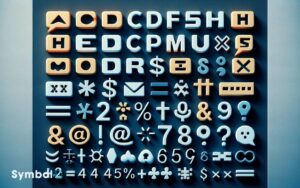How Is Autocorrect Used to Insert Special Characters and Symbols?
Autocorrect helps you insert special characters and symbols quickly. First, you activate autocorrect options in your device or app settings.
Next, customize symbol shortcuts by assigning short abbreviations to complex symbols or special characters you frequently use.
For instance, typing ‘tm’ could automatically convert to ‘™’. This functionality not only speeds up your typing but also guarantees accuracy, particularly with symbols not found on standard keyboards.
It learns from your habits, offering personalized assistance to enhance your typing experience. Activating and customizing these autocorrect features greatly reduces errors and improves efficiency. Discovering more about this can make your digital communication even smoother.

Key Takeaways
Understanding Autocorrect
At its core, autocorrect serves as a tool to streamline your typing, automatically fixing errors and suggesting replacements for misspelled words or phrases.
When you’re typing fast, it’s easy to make mistakes. That’s where autocorrect jumps in. It’s like having a personal editor that scans your text in real-time, making sure what you want to say is communicated clearly and correctly.
You mightn’t notice it, but autocorrect is always working in the background, learning from your habits to become more efficient. It’s not just about fixing typos; autocorrect adapts to your style, understanding your preferences and the context of your conversations.
This personalized assistance makes typing on your device not only faster but also more accurate, ensuring you convey exactly what you intend.
The Basics of Special Characters
Understanding the basics of special characters can greatly improve your typing efficiency and accuracy.
Special characters include symbols and punctuation not found directly on standard keyboards, such as ©, ™, £, €, and mathematical symbols like ≠ or ≤. To utilize these, you’ll often rely on a combination of keys or software features.
For instance, pressing “Alt” plus a sequence of numbers might yield a specific symbol. Alternatively, some operating systems allow you to access a special character menu through shortcuts.
Knowing these shortcuts or sequences can save you time, especially if your work involves diverse languages or technical writing.
Familiarizing yourself with the most commonly used special characters in your field can streamline your workflow and enhance your document’s readability.
Activating Autocorrect Features
Now that you’re familiar with the basics of special characters, it’s time to activate autocorrect features to streamline your typing experience.
You’ll learn how to enable autocorrect options, customize symbol shortcuts, and manage autocorrect settings effectively.
This process will guarantee that your most used symbols and special characters are just a few keystrokes away.
Enabling Autocorrect Options
To activate autocorrect features for special characters and symbols, you’ll first need to enable the autocorrect options in your device’s settings. This step is important as it sets the foundation for a smoother typing experience, especially when you’re frequently using special characters.
Here’s a simple guide to help you enable these options:
| Step | Action | Result |
|---|---|---|
| 1 | Go to Settings | Access device settings |
| 2 | Select Keyboard | Find keyboard options |
| 3 | Choose Typing | Navigate to typing settings |
| 4 | Tap Autocorrect | Locate autocorrect settings |
| 5 | Enable Autocorrect | Autocorrect features activated |
Following these steps ensures autocorrect is ready to assist you, making your typing more efficient and less prone to errors.
Customizing Symbol Shortcuts
Why not tailor your autocorrect settings to instantly convert shorthand into your most-used symbols and special characters?
By customizing symbol shortcuts, you guarantee your typing is both efficient and precise. This is particularly useful in environments where time is of the essence, or specific symbols are frequently required. For instance, students and professionals in mathematics or programming can save valuable time by streamlining how they input common notations or specialized characters. This can be especially advantageous when working on equations that require you to rewrite expressions without absolute value, ensuring clarity and accuracy in problem-solving. Ultimately, such optimizations lead to smoother workflows and reduced cognitive load during repetitive tasks.
To make the most out of this feature, consider:
- Identifying the symbols you use regularly.
- Creating short, memorable codes for each symbol.
- Testing your new shortcuts to make sure they work as expected.
- Keeping a list of your shortcuts until they become second nature.
This customization not only speeds up your typing but also reduces the likelihood of errors, making your digital communication smoother and more professional.
Managing Autocorrect Settings
Once you’ve delved into your symbol shortcuts, it’s crucial to ensure your autocorrect settings are properly activated to make these functions work seamlessly for you. To begin, explore your device’s or application’s settings menu.
You’ll typically find an ‘Autocorrect’ or ‘Text Replacement‘ option under the language or keyboard settings. Confirm this feature is turned on.
Then, if available, personalize the level of autocorrect aggressiveness. Some systems allow you to adjust how assertively autocorrect intervenes, from simply suggesting corrections to automatically implementing changes.
Remember to save your settings before exiting. This step guarantees all your custom shortcuts for special characters and symbols are preserved and will operate as intended.
By managing your autocorrect settings accurately, you’re preparing yourself for a smoother typing experience.
Customizing Autocorrect Entries
Customizing autocorrect entries allows you to streamline your writing process by replacing frequently used phrases or symbols with shorter keystrokes.
This personalization speeds up typing and guarantees accuracy, especially when dealing with complex terminology or foreign languages.
To customize your autocorrect settings effectively, consider these steps:
- Identify Common Errors: Spot the mistakes you often make and set autocorrect to fix them automatically.
- Use Abbreviations: Create abbreviations for long phrases you use regularly.
- Include Symbols: Add special characters or symbols to your autocorrect for quick insertion.
- Regular Updates: Periodically review and update your autocorrect entries to reflect your changing needs.
Popular Autocorrect Shortcuts
Many users find that certain autocorrect shortcuts become indispensable tools in their daily writing tasks. For instance, typing ‘btw‘ can automatically change to ‘by the way,’ streamlining communication and saving time.
Similarly, shortcuts like ‘omw‘ for ‘on my way’ are widely utilized for quick responses. Abbreviations for days of the week, such as ‘Mon‘ for Monday, can also auto-expand, making scheduling and planning more efficient.
Even common misspellings are preemptively corrected; ‘teh‘ becomes ‘the,’ ensuring your text remains professional and polished. While these shortcuts vary by device and software, they’re universally designed to enhance typing speed and accuracy.
You’ll likely find yourself relying on these clever autocorrect features for smoother, more effective text input.
Inserting Symbols With Autocorrect
You’ve learned the basics; now it’s time to enhance your typing efficiency with autocorrect for inserting symbols.
We’ll cover how to understand autocorrect shortcuts, customize your own entries for faster typing, and insert common symbols with quick shortcuts.
This knowledge will streamline your workflow and make your digital communication more effective.
Autocorrect Shortcuts Explained
Autocorrect shortcuts let you swiftly insert symbols and special characters as you type, streamlining your writing process. They work by replacing predefined abbreviations or symbols with the desired character or symbol automatically.
This function can greatly enhance your typing efficiency, especially when dealing with complex documents or frequent special character use.
Benefits of using autocorrect shortcuts include:
- Speed: Instantly convert text into symbols.
- Accuracy: Reduces typing errors.
- Uniformity: Ensures consistent use of symbols.
- Convenience: Simplifies the insertion of complex characters.
Customizing Autocorrect Entries
Understanding the basics of autocorrect shortcuts, it’s now time to learn how to customize these entries for inserting symbols with ease.
First, you’ll need to access the autocorrect options in your text editor or word processor. This is usually found in the settings or tools menu. Once there, you can add new entries to the autocorrect list.
Specify a unique sequence of characters as the trigger, and assign the desired symbol as the replacement. For example, you could use ‘ssmile’ to insert a smiley face symbol. Remember to choose triggers that you’re unlikely to type in normal text, preventing accidental replacements.
After saving your changes, typing your custom triggers will automatically insert the corresponding symbols, streamlining your writing process and enhancing efficiency.
Common Symbols Quick Insert
Enhancing your typing efficiency, you can now quickly insert common symbols using autocorrect shortcuts you’ve set up. This functionality saves time and reduces typing errors, particularly when dealing with symbols that aren’t readily accessible on your keyboard.
To maximize this feature, consider setting up autocorrect shortcuts for:
- @ for email addresses
- € for the Euro symbol
- © for copyright
- → for arrows
These shortcuts transform your workflow, allowing you to continue typing without breaking stride to search for a symbol. It’s crucial to select shortcuts that are intuitive and not likely to conflict with regular word usage.
This approach guarantees that you can type faster and more accurately, enhancing your productivity and the professionalism of your documents.
Autocorrect for Emojis
How often have you wished your phone could automatically insert the perfect emoji based on your typed words? Autocorrect for emojis does just that. It interprets your text and suggests emojis that match your message’s tone or content.
For instance, typing “happy” might prompt a smiley face, while “cake” could suggest a birthday cake emoji.
Here’s a quick guide:
| Typed Word | Emoji Suggestion |
|---|---|
| Happy | 😊 |
| Sad | 😢 |
| Birthday | 🎂 |
| Heart | ❤️ |
This feature saves time and adds a playful dimension to your messages. It’s especially handy in fast-paced messaging environments where conveying emotions quickly is key.
Remember, the effectiveness varies across different devices and applications, shaping how expressively you communicate.
Using Autocorrect in Different Applications
Autocorrect’s functionality can vary greatly across different applications, affecting your typing experience. When you’re typing, whether it’s in a word processor, email client, or messaging app, the way autocorrect handles and inserts special characters and symbols can differ.
Here’s what you might encounter:
- Word processors like Microsoft Word often have extensive autocorrect libraries for symbols.
- Email clients may offer basic autocorrect options, prioritizing speed over complexity.
- Messaging apps frequently focus on emojis and less on other symbols.
- Web browsers mightn’t support autocorrect for symbols unless you’re using a specific extension or plugin.
Understanding these variations guarantees you’re not caught off guard when switching between applications. Each platform has its quirks, and knowing them can streamline your typing and communication.
Tips for Efficient Symbol Insertion
Now that you’re familiar with how different applications handle autocorrect for symbols, let’s look at tips for inserting them more efficiently.
First, learn the shortcuts. Most applications have specific keyboard shortcuts for common symbols, which can drastically speed up your typing.
Next, customize your autocorrect settings. Tailoring these to your most frequently used symbols can save you time.
Additionally, consider using text expansion software. This allows you to assign custom abbreviations to any symbol or piece of text, which then automatically expands to the full version as you type.
Managing Autocorrect Suggestions
Browsing the world of autocorrect suggestions requires understanding how to handle them effectively for a smoother typing experience.
When you’re typing, especially when inserting special characters and symbols, autocorrect can be a handy tool, but it can also offer suggestions that aren’t quite right.
Here’s how to manage those suggestions:
- Review suggestions carefully before choosing to make sure they match your intended input.
- Add frequently used symbols to your autocorrect dictionary for quicker insertion.
- Remove or edit incorrect suggestions from your autocorrect settings to avoid future mistakes.
- Learn shortcut keys for symbols to bypass autocorrect when needed.
Troubleshooting Common Issues
Even with your best attempts to manage autocorrect suggestions, you might still come across issues that need troubleshooting. If autocorrect isn’t inserting the special characters or symbols you anticipate, first, check your device’s language settings.
They must match the language you’re typing in. Sometimes, the solution is as simple as updating your software; outdated versions can glitch.
If problems persist, delve into the autocorrect settings. You might need to reset them or add personal shortcuts for frequently used symbols. This approach tailors autocorrect to better meet your needs.
Don’t forget, too, that external keyboards or apps can clash with your device’s autocorrect function. If you’re using any, make sure they’re compatible and properly configured. These steps usually resolve common autocorrect hiccups, improving your typing experience.
Enhancing Your Typing Speed
You’re ready to boost your typing speed, and the next steps are vital.
Exploring ideal keyboard layouts, mastering shortcut keys, and establishing typing practice routines will get you there.
Each point is designed to make your typing more efficient and faster.
Optimal Keyboard Layouts
Investigating ideal keyboard layouts can greatly enhance your typing speed. While the traditional QWERTY layout is widespread, alternative configurations are designed to increase efficiency and reduce strain.
These include:
- Dvorak Simplified Keyboard: Places the most common letters under your fingers, reducing movement.
- Colemak: Similar to QWERTY but with fewer changes, focusing on common letter pairs.
- Workman: Addresses the flaws in both QWERTY and Dvorak, optimizing finger travel and comfort.
- Maltron: A 3D keyboard layout, considering hand shape and different finger lengths.
Choosing the right layout depends on your willingness to relearn typing and the specific benefits you’re seeking. Switching can initially slow you down, but with practice, you might find your typing speed and comfort significantly improved.
Shortcut Keys Mastery
Have you ever thought about how mastering shortcut keys can greatly enhance your typing speed and efficiency?
Shortcut keys, also known as keyboard shortcuts, are a combination of keys that, when pressed together, perform a specific function. This function could be as simple as copying text with Ctrl+C or as complex as inserting a special character or symbol.
By incorporating these shortcuts into your daily typing routine, you’re not only saving time but also reducing the physical effort of constantly switching between the keyboard and mouse.
Understanding and using these shortcuts can markedly streamline your workflow, making tasks quicker and more seamless.
Start by memorizing the most common shortcuts, then gradually add more to your repertoire as you become more comfortable. It’s a small effort for a big return in productivity.
Typing Practice Routines
After mastering shortcut keys to enhance your typing efficiency, it’s time to focus on improving your typing speed through dedicated practice routines.
To greatly boost your speed, you’ll need to incorporate a variety of exercises that challenge your fingers and brain alike.
Here’s how you can get started:
- Utilize typing software: Programs designed for typing practice can adjust to your skill level, pushing you to improve.
- Practice daily: Even short, daily sessions are better than sporadic, long ones.
- Type, don’t look: Force yourself to type without looking at the keyboard to build muscle memory.
- Focus on accuracy first: Speed will naturally increase as your accuracy improves.
Autocorrect Across Devices
You’ll find that autocorrect for special characters and symbols varies greatly across different devices. On smartphones, autocorrect is often more intuitive due to the limited keyboard space.
It’ll predict and insert special characters based on your typing habits. For instance, typing ‘2moro’ on your phone might automatically correct to ‘tomorrow.’
On desktops and laptops, however, autocorrect functions can be less aggressive, requiring you to use shortcut keys or the character map for special symbols.
Software like Microsoft Word offers more sophisticated autocorrect options, allowing you to define specific shortcuts for inserting symbols you frequently use.
Switching between devices, you’ll need to adapt to each one’s autocorrect quirks. While smartphones excel in predictive text, desktops offer more control, making it necessary to balance convenience with precision in your typing practices.
Future of Autocorrect Evolution
As you look ahead, the evolution of autocorrect seems set to embrace predictive emoji integration, making your messaging more expressive without extra effort.
It’s also expanding multilingual support, ensuring you can communicate effortlessly in any language you choose.
These advancements promise to make autocorrect not just a tool for correction, but a thorough assistant for digital communication.
Predictive Emoji Integration
Delving into the future of autocorrect evolution, predictive emoji integration is set to revolutionize how we communicate by suggesting relevant emojis based on the context of our messages.
This feature isn’t just about adding flair; it’s about enhancing the expressiveness and efficiency of our digital conversations. Imagine typing ‘happy birthday’ and having a birthday cake emoji automatically suggested to you.
Here’s why predictive emoji integration is a game-changer:
- Enhances expressiveness: Adds emotional depth to messages.
- Saves time: No more scrolling through endless emojis.
- Improves accuracy: Suggests the most appropriate emojis.
- Context-aware: Understands the nuance of your message.
This evolution in autocorrect technology is making digital communication more intuitive and engaging, moving beyond mere words to a richer, more expressive form of messaging.
Multilingual Support Expansion
Building on the theme of enhancing digital communication, the future of autocorrect evolution now focuses on expanding multilingual support. This means you’ll soon find it easier than ever to switch between languages while typing, without the hassle of manually changing settings.
Autocorrect’s algorithms are being fine-tuned to identify and adapt to the language you’re using, learning from your typing habits to offer more accurate suggestions and corrections.
This expansion isn’t just about recognizing more languages; it’s about understanding the nuances within them.
Whether you’re texting in English, composing an email in Spanish, or commenting in Mandarin, autocorrect will become your seamless, behind-the-scenes partner.
This evolution aims to make digital communication more inclusive, breaking down language barriers and uniting users across the globe.
Conclusion
To sum up, mastering autocorrect for inserting special characters is like discovering a secret passage in a familiar building it opens up a whole new world of efficiency and expression.
By customizing your settings and familiarizing yourself with popular shortcuts, you’ll breeze through typing like never before.
Whether you’re troubleshooting common issues or syncing preferences across devices, embracing autocorrect’s evolution guarantees your digital communication remains concise, structured, and, most importantly, uniquely yours.






